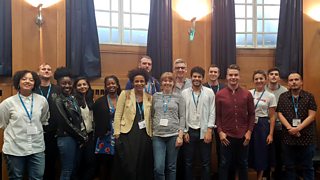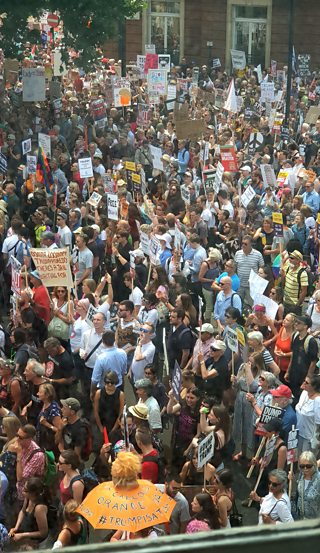Tension was in the air last Friday morning as the gathered for their first session, on the day that the Trump Protest was planned at Portland Place. The sixteen ingenue writers arrived with instructions to cross the famous ±«Óãtv piazza straight to Old Broadcasting House, only to find it blocked by chain fences and muscular security. Cue some W1A-style repartee with reception, until the aptly named producer Marigold Joy rescued us.

The Drama Room writers in the Council Chamber at Broadcasting House
Our first real Drama Room session - we’d met once before at the - was held in the Council Chamber, a grandiose room with ornate windows and portraits of the all the Beeb’s past Director-Generals gazing solemnly down from on high. It began with Anne Edyvean, Head of the ±«Óãtv Writersroom, champion of new voices and sympathetic ex-smoker, giving us an introductory talk about the Drama Room’s opportunities and our potential ‘spec scripts’.
Being part of the Drama Room does not mean we have ±«Óãtv commissions, she explained, but it brings us a lot closer to that step. We’ll get to work with TV, radio and children’s drama over the scheme, and we’ll get the chance to forge relationships with producers. Although many of us are aiming for TV, radio is the biggest commissioner of original drama, where writers like Jack Thorne started. And we’ll write spec scripts, which are not for commission, but to show off our talents.
Suitably energised by all the writing ideas this spurred, it was time for us to spend the rest of the day learning about storytelling with John Yorke. Author of Into the Woods, ‘a five act journey into story’, and de facto Executive Producer of EastEnders since June 2017, he explained to us about developing the perfect screenplay structure. I’d actually already had a session with Yorke as part of a Holby City residency, and so I knew to expect references to Macbeth, ET and The Godfather.
Watch an interview with John Yorke. He explains why he started working with new writers and some common errors that he sees them make. He also describes how he learnt the basics of story structure - the elements which are common to all stories - and how Shakespeare's works can be used to demonstrate their validity.
Why? Because they all follow the same five act structure and archetypal storytelling narrative. ET follows Elliot from selfish to selfless, whilst Macbeth and The Godfather are both ‘dark inversions’ as their protagonist's journey from heroes to monsters. For an audience to really emotionally invest in a story, Yorke stressed sternly but passionately, you must see the protagonist experience inner change through the course of a story. This is what creates a gripping, three-dimensional work.
The biggest obstacle to the protagonist’s change is embodied in the antagonist. Yorke suavely contended with his own speaking antagonist by lunchtime, embodied in the Trump Protest. As thousands of people chanted ‘No Trump, No KKK, No Racist USA!’, the atmosphere in the storytelling session potentially became rife with its own sparks of inspiration. Whilst we learn about thesis, antithesis, and synthesis, the very sound of social protest germinated in our ears.

The view of the Trump protest out of the window of the Council Chamber at Broadcasting House, London.
I left the first Drama Room session alive with ideas, and a passion to apply the power of structure. However, first I headed down to Trafalgar Square to be part of the Protest, and observe the story.
